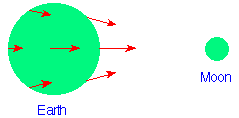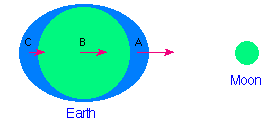 A water molecule in the ocean is attracted to the Earth, but
also to the Moon (much smaller because the Moon is further away and
less massive than Earth). However, the Moon also exerts a gravitational
force on every object in/on the Earth. Tides occur because the
Earth is of a finite size (not infinitely small) and the forces
are not uniform, but depend on distance. Parts closer
to the Moon experience a larger gravitational tug than parts
that are further away.
A water molecule in the ocean is attracted to the Earth, but
also to the Moon (much smaller because the Moon is further away and
less massive than Earth). However, the Moon also exerts a gravitational
force on every object in/on the Earth. Tides occur because the
Earth is of a finite size (not infinitely small) and the forces
are not uniform, but depend on distance. Parts closer
to the Moon experience a larger gravitational tug than parts
that are further away.
These are called Differential Forces and they act on Earth to distort it. The `solid' Earth is rather ridged, and distorts only a bit (making the Earth somewhat `oblate'. The Oceans are more easily deformed, and this leads to the Ocean tides seen.
 A Simple Tidal Model
A Simple Tidal Model
Imagine a planet entirely covered with Ocean. The liquid at
point A (on the left) is closer to the Moon and experiences a
larger gravitational force than point B or the ocean
at point C. It is pulled away from the Earth,
toward the Moon, thus producing the bulge on the right side.
The left side bulge arises because the Earth is
pulled away because the moon's gravitational force
at point B is larger than at point C. As our ocean planet
rotates under these bulges, a given point on the surface
will experience two high and two low tides for each
rotation of the planet.
 Tides in Real Life.
Tides in Real Life.
The tides seen at a given location is a bit more complex than this,
depending on latitude, shape of shore, depth
of ocean and inlets, winds, etc. Typical tides are a meter or
two. The Bay of Fundy, in Nova Scotia Canada, experiences tides up
to 40 feet! Another areas with large tides include, the Gulf of
California (Sea of Cortez) with 24-foot tides at the top of the
bay. The Gulf of Mexico experiences just one, 1-foot, tide per day!